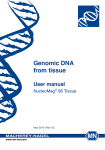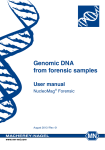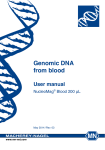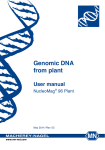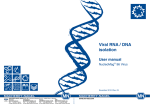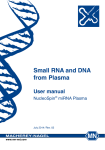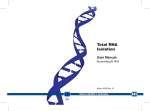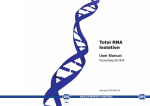Download NucleoMag® Trace - MACHEREY
Transcript
Genomic DNA from forensic samples User manual NucleoMag® Trace August 2015 / Rev. 05 Genomic DNA from forensic samples Table of contents 1Components 4 1.1 Kit contents 1.2 Consumables and equipment to be supplied by user 2 Product description 4 5 6 2.1 The basic principle 6 2.3 Magnetic separation systems 7 2.2 Kit specifications 6 2.4 Adjusting the shaker settings 8 2.6 Elution procedures 9 2.5 Handling of beads 8 3 Storage conditions and preparation of working solutions 10 4 Safety instructions 11 5 Protocol for the isolation of genomic DNA from forensic samples 13 6Appendix 6.1Troubleshooting 6.2 Ordering information 6.3 Product use restriction / warranty MACHEREY-NAGEL – 08/2015, Rev. 05 18 18 20 21 3 Genomic DNA from forensic samples 1 Components 1.1 Kit contents NucleoMag® Trace 1x 96 preps 744600.1 4 x 96 preps 744600.4 24 x 96 preps 744600.24 NucleoMag® B-Beads 1.7 mL 7 mL 42 mL Lysis Buffer FLB 50 mL 250 mL 2 x 500 mL Binding Buffer MB2 45 mL 180 mL 2 x 480 mL Wash Buffer MB3 75 mL 300 mL 2 x 900 mL Wash Buffer MB4 75 mL 300 mL 2 x 900 mL Wash Buffer MB5 125 mL 500 mL 3 x 1000 mL Elution Buffer MB6 30 mL 125 mL 2 x 300 mL Proteinase K (lyophilized)* 50 mg 4 x 50 mg 24 x 50 mg Proteinase Buffer PB 8 mL 15 mL 3 x 35 mL 1 1 1 REF User manual * For preparation of working solutions and storage conditions see section 3. 4 MACHEREY-NAGEL – 08/2015, Rev. 05 Genomic DNA from forensic samples 1.2 Consumables and equipment to be supplied by user Product REF Pack of • Magnetic separator NucleoMag® SEP (see section 2.3) 744900 1 • Separation plate for magnetic beads separation, Square-well Block (96-well block with 2.1 mL squarewells) 740481 740481.24 4 24 • Lysis tubes for incubation of samples and lysis, e.g., Rack of Tubes Strips (1 set consists of 1 Rack, 12 Strips with 8 tubes (1.2 mL wells) each, and 12 Cap Strips) 740477 740477.24 4 sets 24 sets • Elution plate for collecting purified nucleic acids, e.g., Elution Plate U-bottom (96-well 0.3 mL microtiterplate with 300 μL u-bottom wells) 740486.24 24 • For use of kit on KingFisher® 96 instrument: e.g., KingFisher® 96 Accessory Kit A (Square-well Blocks, Deep-well tip combs, Plates for 4 x 96 NucleoMag® Trace preps using KingFisher® 96 platform) 744950 1 set MACHEREY-NAGEL – 08/2015, Rev. 05 5 Genomic DNA from forensic samples 2 Product description 2.1 The basic principle The NucleoMag® Trace procedure is based on reversible adsorption of nucleic acids to paramagnetic beads under appropriate buffer conditions. Lysis is achieved by incubation of samples with Proteinase K at room temperature or 56 °C. For the adjustment of binding conditions under which nucleic acids bind to the paramagnetic beads, Buffer MB2 and the NucleoMag® B-Beads are added to the lysate. After magnetic separation, the paramagnetic beads are washed twice to remove contaminants and salts using Wash Buffers MB3 and MB4. Residual ethanol from previous wash steps is removed by Wash Buffer MB5. Finally, highly purified DNA is eluted with low-salt Elution Buffer (MB6) and can directly be used for downstream applications. The NucleoMag® Trace kit can be used either manually or automated on standard liquid handling instruments or automated magnetic separators. 2.2 Kit specifications • NucleoMag® Trace is designed for rapid manual and automated small-scale preparation of highly pure genomic DNA from buccal swabs or other samples, for example, dried blood spots or cigarette filters. The kit is designed for use with NucleoMag® SEP magnetic separator plate (see ordering information) or other magnetic separation systems (see section 2.3). Manual time for the preparation of 96 samples is about 120 minutes. The purified DNA can be used directly as template for PCR, or any kind of enzymatic reactions. • NucleoMag® Trace allows easy automation on common liquid handling instruments or automated magnetic separators. The actual processing time depends on the configuration of the instrument and the magnetic separation system used. Typically, 96 samples can be purified in less than 120 minutes using the NucleoMag® SEP on the automation platform. • The kit provides reagents for the purification of up to 7 μg of pure genomic DNA from suitable samples (typical yields for DNA isolation from buccal swabs: 1–3 μg DNA) Depending on the elution volume used, concentrations of 10–30 ng/μL can be obtained. • Following lysis of samples with Proteinase K at 56 °C (recommended, optional: Proteinase K treatment can be performed at RT) NucleoMag® Trace can be processed completely at room temperature, however, elution at 56 °C will increase the yield by about 15–20 %. • NucleoMag® B-Beads are highly reactive, superparamagnetic beads. The binding capacity is 0.4 μg of gDNA per 1 μL of NucleoMag® B-Bead suspension, 1 μL of suspension contains 130 μg of beads 6 MACHEREY-NAGEL – 08/2015, Rev. 05 Genomic DNA from forensic samples 2.3 Magnetic separation systems For use of NucleoMag® Trace, the use of the magnetic separator NucleoMag® SEP is recommended. Separation is carried out in a Square-well Block (see ordering information). The kit can also be used with other common separators. Magnetic separator Separation plate or tube NucleoMag® SEP (MN REF 744900) Square-well Block (MN REF 740481) Tecan Te-MagS™ 1.5 mL tubes without lid (Sarstedt) Static magnetic pins Separators with static magnetic pins, for example, NucleoMag® SEP (for manual use and for use on liquid handling workstations): This type of separator is recommended in combination with a suitable microplate shaker for optimal resuspension of the beads during the washing and elution steps. Alternatively, beads can be resuspended in the buffer by pipetting up and down several times. For fully-automated use on liquid handling workstations, a gripper tool is required, the plate is transferred to the magnetic separator for separation of the beads and transferred to the shaker module for resuspension of the beads. Movable magnetic systems Separators with moving magnetic pins: Magnetic pins / rods are moved from one side of the well to the other and vice versa. Beads follow this movement and are thus pulled through the buffer during the wash and elution steps. Separation takes place when the system stops. Automated separators Separators with moving magnets: Magnetic beads are transferred into suitable plates or tubes. Beads are resuspended from the rod-covered magnets. Following binding, washing or elution beads are collected again with the rod-covered magnets and transferred to the next plate or tube. MACHEREY-NAGEL – 08/2015, Rev. 05 7 Genomic DNA from forensic samples 2.4 Adjusting the shaker settings When using a plate shaker for the washing and elution steps, the speed settings have to be adjusted carefully for each specific separation plate and shaker to prevent crosscontamination from well to well. Proceed as follows: Adjusting shaker speed for binding and wash steps: • Load 600 μL dyed water to the wells of the separation plate. Place the plate on the shaker and start shaking with a moderate speed setting for 30 seconds. Turn off the shaker and check the plate surface for small droplets of dyed water. • Increase speed setting, shake for an additional 30 seconds, and check the plate surface for droplets again. • Continue increasing the speed setting until you observe droplets on top of the separation plate. Reduce speed setting, check again, and use this setting for the washing step. Adjusting shaker speed for the elution step: • Load 100–200 μL dyed water to the wells of the collection plate and proceed as described above. 2.5 Handling of beads Distribution of beads A homogeneous distribution of the magnetic beads to the individual wells of the separation plate is essential for a high well-to-well consistency. Therefore, before distributing the beads, make sure that the beads are completely resuspended. Shake the storage bottle well or place it on a vortexer shortly. Premixing magnetic beads with the binding buffer allows easier homogenous distribution of the beads to the individual wells of the separation plate. During automation, a premix step before aspirating the beads / binding buffer mixture from the reservoir is recommended to keep the beads resuspended. Magnetic separation time Attraction of the magnetic beads to the magnetic pins depends on the magnetic strength of the magnetic pins, the selected separation plate, distance of the separation plate from the magnetic pins, and the volume to be processed. The individual times for complete attraction of the beads to the magnetic pins should be checked and adjusted on each system. It is recommended using the separation plates or tubes specified by the supplier of the magnetic separator. 8 MACHEREY-NAGEL – 08/2015, Rev. 05 Genomic DNA from forensic samples Washing the beads Washing the beads can be achieved by shaking or mixing. In contrast to mixing by pipetting up and down, mixing by shaker or magnetic mixing allows simultaneous mixing of all samples. This reduces the time and number of tips needed for the preparation. Resuspension by pipetting up and down, however, is more efficient than mixing by a shaker or magnetic mix. Resuspension efficiency Speed Magnetic mix + ++ + Low Shaker ++ ++ +++ Low Pipetting +++ +* ++ High Method Small elution Number of tips volume possible needed +: acceptable, ++: good, +++: excellent 2.6 Elution procedures Purified DNA can be eluted directly with the supplied Elution Buffer MB6. Elution can be carried out in a volume of ≥ 50 μL. It is essential to cover the NucleoMag® Beads completely with elution buffer during the elution step. The volume of dispensed elution buffer depends on the magnetic separation system (e.g., the position of the pellet inside the separation plate). For efficient elution, the magnetic bead pellet should be resuspended completely in the elution buffer. For some separators, higher elution volumes might be necessary to cover the whole pellet. Elution is possible at room temperature. Yield can be increased by 15–20 % if elution is performed at 56 °C. MACHEREY-NAGEL – 08/2015, Rev. 05 9 Genomic DNA from forensic samples 3 Storage conditions and preparation of working solutions Attention: Buffers MB2, MB3, and MB4 contain chaotropic salt! Wear gloves and goggles! Storage conditions: • All components of the NucleoMag® Trace kit should be stored at room temperature (18–25 °C) and are stable for at least one year. • All buffers are delivered ready-to-use. Before starting any NucleoMag® Trace protocol, prepare the following: • Proteinase K: Add the indicated volume of Proteinase Buffer PB to dissolve lyophilized Proteinase K. Proteinase K solution is stable at - 20 °C for at least 6 months. NucleoMag® Trace REF Proteinase K (lyophilized) 10 1 x 96 preps 744600.1 4 x 96 preps 744600.4 24 x 96 preps 744600.24 1 x 50 mg Add 2.5 mL Proteinase Buffer 4 x 50 mg Add 2.5 mL Proteinase Buffer to each vial 24 x 50 mg Add 2.5 mL Proteinase Buffer to each vial MACHEREY-NAGEL – 08/2015, Rev. 05 Genomic DNA from forensic samples 4 Safety instructions The following components of the NucleoMag® Trace kits contain hazardous contents. Wear gloves and goggles and follow the safety instructions given in this section. GHS classification Only harmful features do not need to be labeled with H and P phrases up to 125 mL or 125 g. Mindergefährliche Eigenschaften müssen bis 125 mL oder 125 g nicht mit H- und P-Sätzen gekennzeichnet werden. Component Hazard contents GHS symbol Hazard phrases Precaution phrases Inhalt Gefahrstoff GHS-Symbol H-Sätze P-Sätze MB2 Ethanol 35–55 % + sodium perchlorate 20–40 % 226, 302 210, 233, 301+312, 330, 370+378, 403+235 226 210, 233, 370+378, 403+235 317, 334 261, 272, 280, 302+352, 304+340, 333+313, 342+311, 363 Ethanol 35–55 % + Natriumperchlorat 20–40% MB3, MB4 CAS 64-17-5, 7601-89-0 ACHTUNG Ethanol 20–35 % Ethanol 20–35 % CAS 64-17-5 Proteinase K WARNING Proteinase K (lyophilized) 90–100 % Proteinase K (lyophilisiert) 90–100 % CAS 39450-01-6 WARNING ACHTUNG WARNING ACHTUNG Hazard phrases H226 Flammable liquid and vapour. H302 Harmful if swallowed. H317 May cause an allergic skin reaction. H334 Flüssigkeit und Dampf entzündbar. Gesundheitsschädlich bei Verschlucken. Kann allergische Hautreaktionen verursachen. May cause allergy or asthma symptoms or breathing difficulties if inhaled. Kann bei Einatmen Allergie, asthmaartige Symptome oder Atembeschwerden verursachen. Precaution phrases P210 P233 Keep away from heat, hot surfaces, sparks, open flames and other ignition sources. No smoking. on Hitze, heissen Oberflächen, Funken, offenen Flammen sowie anderen Zündquellenarten V fernhalten. Nicht rauchen. Keep container tightly closed. Behälter dicht verschlossen halten. MACHEREY-NAGEL – 08/2015, Rev. 05 11 Genomic DNA from forensic samples P261 Avoid breathing dust/fume/gas/mist/vapours/spray. P272 Contaminated work clothing should not be allowed out of the workplace. P280 Wear protective gloves/protective clothing/eye protection/face protection. P301+312 IF SWALLOWED: Call a POISON CENTER/ doctor/…/ if you feel unwell. P302+352 IF ON SKIN: Wash with plenty of water/… P304+340 IF INHALED: Remove person to fresh air and keep comfortable for breathing. P330 Rinse mouth. P333+313 If skin irritation or rash occurs: Get medical advice/attention. P342+311 If experiencing respiratory symptoms: Call a POISON CENTER/doctor/… P370+378 Einatmen von Staub/Rauch/Gas/Nebel/Dampf/Aerosol vermeiden. Kontaminierte Arbeitskleidung nicht außerhalb des Arbeitsplatzes tragen. Schutzhandschuhe/Schutzkleidung/Augenschutz/Gesichtsschutz tragen. BEI VERSCHLUCKEN: Bei Unwohlsein GIFTINFORMATIONSZENTRUM/Arzt/… anrufen. BEI BERÜHRUNG MIT DER HAUT: Mit viel Wasser/… waschen. BEI EINATMEN: Die Person an die frische Luft bringen und für ungehinderte Atmung sorgen. Mund ausspülen. Bei Hautreizung oder -ausschlag: Ärztlichen Rat einholen/ärztliche Hilfe hinzuziehen. Bei Symptomen der Atemwege: GIFTINFORMATIONSZENTRUM/Arzt/… anrufen. In case of fire: Use … to extinguish. Bei Brand: … zum Löschen verwenden. P363 Wash contaminated clothing before reuse. P403+235 Store in a well-ventilated place. Keep cool. Kontaminierte Kleidung vor erneutem Tragen waschen. An einem gut belüfteten Ort aufbewahren. Kühl halten. For further information please see Material Safety Data Sheets (www.mn-net.com). Weiterführende Informationen finden Sie in den Sicherheitsdatenblättern (www.mn-net.com). The symbol shown on labels refers to further safety information in this section. Das auf Etiketten dargestellte Symbol weist auf weitere Sicherheitsinformationen dieses Kapitels hin. 12 MACHEREY-NAGEL – 08/2015, Rev. 05 NucleoMag® Trace 5 Protocol for the isolation of genomic DNA from forensic samples Protocol-at-a-glance • For additional equipment and hardware requirements, refer to section 1.2 and 2.3, respectively. • For detailed information on each step, see page 15. Before starting the preparation: • Check if Proteinase K was prepared according to section 3. 1 Lyse sample (e.g., buccal swabs) Add 25 μL Proteinase K solution and 200–400 μL Buffer FLB Mix 56 °C, 1 h 2 Separate lysate from sample material, transfer 225 μL of lysate to a Square-well Block for further processing 3 Bind DNA to NucleoMag® B-Beads 225 μL lysate 14 μL NucleoMag® B-Beads 360 μL MB2 Mix by shaking for 5 min at RT (Optional: Mix by pipetting up and down) After 2 min separation, remove supernatant 4 Wash with MB3 Remove Square-well Block from NucleoMag® SEP 600 μL MB3 Resuspend: Shake 5 min at RT (Optional: Mix by pipetting up and down) MACHEREY-NAGEL – 08/2015, Rev. 05 13 NucleoMag® Trace After 2 min separation, remove supernatant 5 Wash with MB4 Remove Square-well Block from NucleoMag® SEP 600 μL MB4 Resuspend: Shake 5 min at RT (Optional: Mix by pipetting up and down) After 2 min separation, remove supernatant 6 Wash with MB5 Leave Square-well Block on NucleoMag® SEP 900 μL MB5 Incubate for 45–60 s Note: Do not resuspend the beads in Buffer MB5! Remove supernatant 7 Elute DNA Remove Square-well Block from NucleoMag® SEP 50–200 μL MB6 (Optional: Elute at 56 °C) Shake 5 min at RT (Optional: Mix by pipetting up and down) Separate 2 min and transfer DNA into elution plate / tubes 14 MACHEREY-NAGEL – 08/2015, Rev. 05 NucleoMag® Trace Detailed protocol This protocol is designed for magnetic separators with static pins (e.g., NucleoMag® SEP) and suitable plate shakers (see section 2.3). It is recommended using a Square-well Block for separation (see section 1.2). Alternatively, isolation of DNA can be performed in reaction tubes with suitable magnetic separators. This protocol is for manual use and serves as a guideline for adapting the kit to robotic instruments. Before starting the preparation: • Check if Proteinase K was prepared according to section 3. Sample collection Collect the samples with cotton, Dacron, or C.E.P. swabs. Scrape firmly against the inside of each cheek several times and let the swabs air dry. The respective individual should not have consumed food or drink within 30 min before collection of the sample. Samples should be processed immediately or stored at 4 °C. 1 Lyse samples Calculate the amount of lysis stock required: for each sample, 25 μL of Proteinase K solution + 200 μL Buffer FLB are required. Prepare lysis stock solution accordingly and vortex. Note: Never prepare the lysis stock solution more than 15 min before addition to the samples. Proteinase K tends to self digestion when incubated in Buffer FLB without substrate. Transfer 225 μL of the resulting solution to each lysis tube containing the buccal swab head. Close the individual tubes. Mix by vigorous shaking for 10–15 s. Spin briefly (15 s; 1,500 x g) to collect any sample at the bottom of the tube. Note: The buccal swab heads should be submerged into the lysis solution. Therefore, depending on type or size of buccal swab used the FLB buffer volume has to be increased to up to 400 μL. Increasing volume of Proteinase K solution is not required. Alternatively, perform lysis with Buffer FLB / Proteinase K in a NucleoSpin® Trace Filter Plate (see ordering information). This plate allows convenient separation of lysate from swab material by centrifugation and reduces loss of lysate. Incubate the tubes containing the samples at 56 °C for 1 h or overnight at room temperature. For optimal lysis, mix occasionally during incubation. Make sure that the lysis tubes are securely closed. Note: Other samples (e.g., dried blood spots, cigarette filters) can be processed accordingly. MACHEREY-NAGEL – 08/2015, Rev. 05 15 NucleoMag® Trace 2 Separate lysate Separate swab material from lysed sample. Remove buccal swab and squeeze out to obtain 225 μL lysate. When using increased volumes (> 200 μL) of Buffer FLB in step 1 of the procedure, transfer 225 μL lysed sample to a new Square-well Block for further processing. When using the NucleoSpin® Trace Filter Plate, centrifuge the NucleoSpin® Trace Filter Plate stacked onto a 96 well Square-well Block for 5 min at 5,600 x g to draw the lysate out of the swab material. 3 Bind DNA to NucleoMag® B-Beads To each lysate of 225 μL from the previous step, add 14 μL of NucleoMag® B-Beads and 360 μL of Binding Buffer MB2. Mix by pipetting up and down 6 times and shake for 5 min at room temperature. Alternatively, when processing the kit without a shaker, pipette up and down 10 times and incubate for 5 min at room temperature. Note: NucleoMag® B-Beads and Buffer MB2 can be premixed. Per well to be processed, mix 14 μL of NucleoMag® B-Beads with 360 μL Buffer MB2. Vortex briefly. Depending on the dead volume of the reservoir, additional amounts of bead suspension and binding buffer are required. Be sure to resuspend the NucleoMag® B-Beads before removing them from the storage bottle. Vortex storage bottle briefly until a homogenous suspension has formed. Separate the magnetic beads against the side of the wells by placing the Square-well Block on the NucleoMag® SEP magnetic separator. Wait at least 2 min until all the beads have been attracted to the magnets. Remove and discard supernatant by pipetting. Note: Do not disturb the attracted beads while aspirating the supernatant. The magnetic pellet is not visible in this step. Remove supernatant from the opposite side of the well. 4 Wash with MB3 Remove the Square-well Block from the NucleoMag® SEP magnetic separator. Add 600 μL Buffer MB3 to each well and resuspend the beads by shaking until the beads are resuspended completely (5 min). Alternatively, resuspend beads completely by repeated pipetting up and down (15 times). 16 MACHEREY-NAGEL – 08/2015, Rev. 05 NucleoMag® Trace Separate the magnetic beads by placing the Square-well Block on the NucleoMag® SEP magnetic separator. Wait at least 2 min until all the beads have been attracted to the magnet. Remove and discard supernatant by pipetting. 5 Wash with MB4 Remove the Square-well Block from the NucleoMag® SEP magnetic separator. Add 600 μL Buffer MB4 to each well and resuspend the beads by shaking until the beads are resuspended completely (5 min). Alternatively, resuspend beads completely by repeated pipetting up and down (15 times). Separate the magnetic beads by placing the Square-well Block on the NucleoMag® SEP magnetic separator. Wait at least 2 min until all the beads have been attracted to the magnet. Remove and discard supernatant by pipetting. 6 Wash with MB5 Leave the Square-well Block on the NucleoMag® SEP magnetic separator. Note: Supernatant is colorless, magnetic bead pellet is clearly visible. Gently add 900 μL Buffer MB5 to each well and incubate for 45–60 s while the beads are still attracted to magnets. Then aspirate and discard the supernatant. Note: Do not resuspend the beads in Wash Buffer MB5. This step is to remove traces of ethanol and eliminates a drying step! 7 Elute DNA Remove the Square-well Block from the NucleoMag® SEP magnetic separator. Add desired volume of Buffer MB6 (50–200 μL) to each well of the Square-well Block and resuspend the beads by shaking 5–10 min at room temperature or 56 °C. Alternatively, resuspend beads completely by repeated pipetting up and down and incubate for 5–10 min at room temperature or 56 °C. Separate the magnetic beads by placing the Square-well Block on the NucleoMag® SEP magnetic separator. Wait at least 2 min until all the beads have been attracted to the magnets. Transfer the supernatant containing the purified genomic DNA to the Elution Plate. Note: Yield can be increased by 15–20 % by using pre-heated elution buffer (56 °C) or by incubating the bead / elution buffer suspension at 56 °C for 10 min. MACHEREY-NAGEL – 08/2015, Rev. 05 17 Genomic DNA from forensic samples 6 Appendix 6.1 Troubleshooting Problem Possible cause and suggestions Elution buffer volume insufficient • Beads pellet must be covered completely with elution buffer. Insufficient performance of elution buffer during elution step • Remove residual buffers during the separation steps completely. Remaining buffers decrease efficiency of following wash steps and elution step. Beads dried out • Do not let the beads dry as this might result in lower elution efficiencies. Partial elution in Wash Buffer MB5 already Poor DNA yield • Keep the beads on the magnet while dispensing Wash Buffer MB5. Do not resuspend beads in this buffer and do not incubate beads in this buffer for more than 2 min, as this buffer is water-based and might elute the DNA already. Aspiration of attracted bead pellet • Do not disturb the attracted beads while aspirating the supernatant, especially when the magnetic pellet is not visible in the lysate. Incubation after dispensing beads to lysate • Mix immediately after dispensing NucleoMag® B-Beads / Buffer MB2 to the lysate. Aspiration and loss of beads • Time for magnetic separation was too short or aspiration speed was too high. Insufficient washing procedure Low purity 18 • Use only the appropriate combinations of separator and plate, for example, Square-well Block in combination with NucleoMag® SEP. • Make sure that beads are resuspended completely during the washing procedure. If shaking is not sufficient to resuspend the beads completely mix by repeated pipetting up and down. MACHEREY-NAGEL – 08/2015, Rev. 05 Genomic DNA from forensic samples Problem Suboptimal performance of DNA in downstream applications Possible cause and suggestions Carry-over of ethanol from wash buffers • Be sure to remove all of the ethanolic wash solution, as residual ethanol interferes with downstream applications. Low purity • See above Time for magnetic separation too short • Carry-over of beads Increase separation time to allow the beads to be completely attracted to the magnetic pins before aspirating any liquid from the well. Aspiration speed too high (elution step) • High aspiration speed during the elution step may cause bead carry-over. Reduce aspiration speed for elution step. Contamination of the rims Cross contamination • Do not moisten the rims of the Square-well Block when transferring the lysate. If the rim of the wells is contaminated, seal the Square-well Block with Self-adhering PE Foil (see ordering information) before starting the shaker. MACHEREY-NAGEL – 08/2015, Rev. 05 19 Genomic DNA from forensic samples 6.2 Ordering information Product REF Pack of NucleoMag® Trace 744600.1 744600.4 744600.24 1 x 96 preps 4 x 96 preps 250 x 96 preps NucleoMag® Trace 740988.10 740988.50 740988.250 10 x 96 pieces 50 x 96 pieces 250 x 96 pieces NucleoSpin® Forensic Filters (Bulk) 740988.50B 740988.250B 740988.1000B 50 x 96 pieces 250 x 96 pieces 1000 x 96 pieces NucleoSpin® Trace Filter Plate 740677 20 NucleoMag® SEP 744900 1 Square-well Blocks 740481 740481.24 4 24 Square-well Blocks, ethylene oxide treated 740481EO 4 Self-adhering PE Foil 740676 50 sheets Rack of Tube Strips 740477 740477.24 4 sets 24 sets Cap Strips 740638 30 strips KingFisher® 96 Accessory Kit A 744950 1 set (set consists of 1 Rack, 12 Tube Strips with 8 tubes each, and 12 Cap Strips) (set consists of Square-well Blocks, Deep-well tip combs, Elution Plates; for 4 x 96 NucleoMag® Trace preps using KingFisher® 96 platform) Visit www.mn-net.com for more detailed product information. 20 MACHEREY-NAGEL – 08/2015, Rev. 05 Genomic DNA from forensic samples 6.3 Product use restriction / warranty NucleoMag® Trace kit components are intended, developed, designed, and sold FOR RESEARCH PURPOSES ONLY, except, however, any other function of the product being expressly described in original MACHEREY-NAGEL product leaflets. MACHEREY-NAGEL products are intended for GENERAL LABORATORY USE ONLY! MACHEREY-NAGEL products are suited for QUALIFIED PERSONNEL ONLY! MACHEREY-NAGEL products shall in any event only be used wearing adequate PROTECTIVE CLOTHING. For detailed information please refer to the respective Material Safety Data Sheet of the product! MACHEREY-NAGEL products shall exclusively be used in an ADEQUATE TEST ENVIRONMENT. MACHEREY-NAGEL does not assume any responsibility for damages due to improper application of our products in other fields of application. Application on the human body is STRICTLY FORBIDDEN. The respective user is liable for any and all damages resulting from such application. DNA/RNA/PROTEIN purification products of MACHEREY-NAGEL are suitable for IN VITRO-USES ONLY! ONLY MACHEREY-NAGEL products specially labeled as IVD are also suitable for IN VITRO-diagnostic use. Please pay attention to the package of the product. IN VITROdiagnostic products are expressly marked as IVD on the packaging. IF THERE IS NO IVD SIGN, THE PRODUCT SHALL NOT BE SUITABLE FOR IN VITRO-DIAGNOSTIC USE! ALL OTHER PRODUCTS NOT LABELED AS IVD ARE NOT SUITED FOR ANY CLINICAL USE (INCLUDING, BUT NOT LIMITED TO DIAGNOSTIC, THERAPEUTIC AND/OR PROGNOSTIC USE). No claim or representations is intended for its use to identify any specific organism or for clinical use (included, but not limited to diagnostic, prognostic, therapeutic, or blood banking). It is rather in the responsibility of the user or - in any case of resale of the products - in the responsibility of the reseller to inspect and assure the use of the DNA/RNA/protein purification products of MACHEREY-NAGEL for a well-defined and specific application. MACHEREY-NAGEL shall only be responsible for the product specifications and the performance range of MN products according to the specifications of in-house quality control, product documentation and marketing material. This MACHEREY-NAGEL product is shipped with documentation stating specifications and other technical information. MACHEREY-NAGEL warrants to meet the stated specifications. MACHEREY-NAGEL´s sole obligation and the customer´s sole remedy is limited to replacement of products free of charge in the event products fail to perform as warranted. Supplementary reference is made to the general business terms and conditions of MACHEREY-NAGEL, which are printed on the price list. Please contact us if you wish to get an extra copy. There is no warranty for and MACHEREY-NAGEL is not liable for damages or defects arising in shipping and handling (transport insurance for customers excluded), or out of accident or improper or abnormal use of this product; defects in products or MACHEREY-NAGEL – 08/2015, Rev. 05 21 Genomic DNA from forensic samples components not manufactured by MACHEREY-NAGEL, or damages resulting from such non-MACHEREY-NAGEL components or products. MACHEREY-NAGEL makes no other warranty of any kind whatsoever, and SPECIFICALLY DISCLAIMS AND EXCLUDES ALL OTHER WARRANTIES OF ANY KIND OR NATURE WHATSOEVER, DIRECTLY OR INDIRECTLY, EXPRESS OR IMPLIED, INCLUDING, WITHOUT LIMITATION, AS TO THE SUITABILITY, REPRODUCTIVITY, DURABILITY, FITNESS FOR A PARTICULAR PURPOSE OR USE, MERCHANTABILITY, CONDITION, OR ANY OTHER MATTER WITH RESPECT TO MACHEREY-NAGEL PRODUCTS. In no event shall MACHEREY-NAGEL be liable for claims for any other damages, whether direct, indirect, incidental, compensatory, foreseeable, consequential, or special (including but not limited to loss of use, revenue or profit), whether based upon warranty, contract, tort (including negligence) or strict liability arising in connection with the sale or the failure of MACHEREY-NAGEL products to perform in accordance with the stated specifications. This warranty is exclusive and MACHEREY-NAGEL makes no other warranty expressed or implied. The warranty provided herein and the data, specifications and descriptions of this MACHEREY-NAGEL product appearing in MACHEREY-NAGEL published catalogues and product literature are MACHEREY-NAGEL´s sole representations concerning the product and warranty. No other statements or representations, written or oral, by MACHEREY-NAGEL´s employees, agent or representatives, except written statements signed by a duly authorized officer of MACHEREY-NAGEL are authorized; they should not be relied upon by the customer and are not a part of the contract of sale or of this warranty. Product claims are subject to change. Therefore please contact our Technical Service Team for the most up-to-date information on MACHEREY-NAGEL products. You may also contact your local distributor for general scientific information. Applications mentioned in MACHEREY-NAGEL literature are provided for informational purposes only. MACHEREY-NAGEL does not warrant that all applications have been tested in MACHEREY-NAGEL laboratories using MACHEREY-NAGEL products. MACHEREYNAGEL does not warrant the correctness of any of those applications. Last updated: 07 / 2010, Rev. 03 Please contact: MACHEREY-NAGEL GmbH & Co. KG Tel.: +49 24 21 969-270 [email protected] Trademarks: KingFisher® is a registered trademark of Thermo Fisher Scientific NucleoMag® is a registered trademark of MACHEREY-NAGEL GmbH & Co KG Te-MagS™ is a trademark of Tecan Group Ltd., Switzerland All used names and denotations can be brands, trademarks, or registered labels of their respective owner – also if they are not special denotation. To mention products and brands is only a kind of information (i.e., it does not offend against trademarks and brands and can not be seen as a kind of recommendation or assessment). Regarding these products or services we can not grant any guarantees regarding selection, efficiency, or operation. 22 MACHEREY-NAGEL – 08/2015, Rev. 05 EN ISO 9001 EN ISO 13485 CERTIFIED MACHEREY-NAGEL GmbH & Co. KG · Neumann-Neander-Str. 6–8 · 52355 Düren · Germany France: Switzerland: Germany USA: MACHEREY-NAGEL EURL MACHEREY-NAGEL Inc. MACHEREY-NAGEL AG and international: Tel.: +33 388 68 22 68 Tel.: +41 62 388 55 00 Tel.: +49 24 21 969-0 Tel.: +1 484 821 0984 E-mail: [email protected] E-mail: [email protected] E-mail: [email protected] E-mail: [email protected] A033242/0850.08 MACHEREY-NAGEL






















